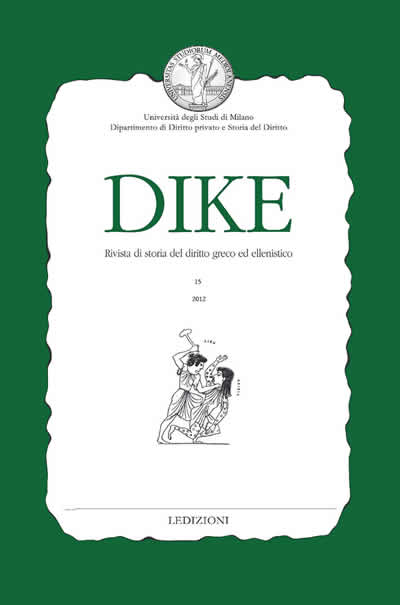NAGIDOS, ARSINOE AND ISOPOLITEIA
DOI:
https://doi.org/10.13130/1128-8221/3495Abstract
The article treats one specific aspect of the well-known dossier of Nagidos and Arsinoe. It focuses on LL. 34-35 that, according to the communis opinio, contain a grant of isopolity as W. Gawantka once defined it. The analysis of both content and form of the decree (LL. 19-56) suggest, however, that these lines do not imply the use of this institution. Instead they refer either to a project of isopolity that would have been viable only after Arsinoe had fulfilled several requirements, namely after it had become a polis (to the eyes of Nagidos). Or they imply the concession of politeia to a group of people who did not belong to a polis, in which case we should not speak of the Hellenistic diplomatic tool studied by Gawantka.
L’articolo affronta un problema preciso posto dal dossier delle città di Arsinoe e Nagidos: le LL. 34-35 del decreto di Nagidos infatti sono sempre state interpretate come se contenessero la concessione di cittadinanza potenziale, secondo la definizione che ne diede W. Gawantka nel 1975. L’analisi contenutistica e formale del testo del decreto scoraggiano tuttavia dal sostenere questa tesi, mentre è piú probabile che queste stesse linee si riferiscano o ad un progetto di isopoliteia, da poter concedere solo dopo l’adozione di misure e l’attuazione di provvedimenti che avrebbero reso Arsinoe una polis (agli occhi di Nagidos), oppure che non si tratti affatto dell’istituto diplomatico ellenistico, ma della concessione di politeia ad un gruppo di persone non inquadrate in un contesto civico, gli Arsinoei per l’appunto, almeno secondo Nagidos.
Riferimenti bibliografici
Ager Sh., Interstate Arbitrations in the Greek World, Berkeley 1996 Bencivenni A., Progetti di riforme costituzionali nelle epigrafi greche dei secoli IV-II a.C., Bologna 2003
Boffo L., “Lo statuto di terre, insediamenti e persone nell’Anatolia ellenistica. Documenti recenti e problemi antichi,” Dike 4, 2001, pp. 233-25
Chaniotis A., “Ein diplomatischer Statthalter nimmt Rücksicht auf den verletzten Stolz zweier hellenistischer Kleinpoleis (Nagidos und Arsinoe),” EA 21, 1993, pp. 33-42 Chaniotis A., Die Verträge zwischen kretischen Poleis in der hellenistischen Zeit, Stuttgart 1996 Criscuolo L., “Il diaceta Apollonio e Arsinoe,” in Le culte du souverain dans
l’Égypte Ptolémaique au IIIe siècle avant notre ère, Actes du coll. Intern., Bruxelles 10 mai 1995, Leuven 1998, pp. 61–72
Daubner F., “Eine ἀποικία in einer hellenistischen Inschrift aus Tyros,” ZPE 168, 2009, pp. 177 – 182
Fröhlich P., “L’inventaire du monde des cités grecques. Une somme, une méthode et une conception de l’histoire,” RHIS 102, 2010, pp. 637-676
Gauthier Ph., “Épigraphie et institutions grecques,” EPHE 110, 1977-78, pp. 373-378
Gauthier Ph., “Epigraphica,” RPh 64, 1990, pp. 61–70
Gauthier Ph., Symbola. Les étrangers et la justice dans les cités grecques, Nancy 1972 Gawantka W., Isopolitie. Ein Beitrag zur Geschichte der zwischenstaatlichen Beziehungen in der griechischen Antike, Munich 1975. Gschnitzer F., “Ἐπὶ τοῖσδε ἔδωκαν Πρασίοι Σταλίταις τὰν χώραν. Zu einem Geschäftstyp des griechischen Völkerrechts,” in Symposion 1971, Vienna 1975, pp. 79–102 now also in “Kleine Schriften zum griechischen und römischen Altertum II” ed. Trümpy, Stuttgart 2003, pp. 121-144
Gschnitzer F., Abhängige Orte im griechischen Altertum, Munich 1958 Habicht Ch., “A Hellenistic inscription from Arsinoe in Cilicia,” Phoenix 43, 1989, pp. 317-346
Hansen M. H., “A Typology of Dependent Poleis,” in Yet More Studies in the Ancient Greek Poleis, ed. Nielsen, Stuttgart 1997, pp. 30-37
Hengstl J., “‘Lokales Recht’ im außerrömischen Bereich – anhand einer neugefundenen Inschrift aus dem ptolemäischen Kilikien,” ZRG 109, 1992, pp. 486-500
Hennig D., “Staatliche Ansprüche an privaten Immobilienbesitz in der klassischen und hellenistischen Polis,” Chiron 25, 1995, pp. 235-282
Jones C. P. and Habicht Ch., “A Hellenistic inscription from Arsinoe in Cilicia,” Phoenix 43, 1989, pp. 317-346
Jones C. P. and Habicht Ch., “A Hellenistic inscription from Arsinoe in Cilicia,” Phoenix 43, 1989, pp. 317-346 now also as Habicht Ch., “The Hellenistic Monarchies. Selected Papers,” Ann Arbor 2006, pp. 243-274
LaBuff J., “The Union of Latmos and Pidasa Reconsidered,” EA 43, 2010, pp. 115-124
Mueller K., Settlements of the Ptolemies: city foundations and new settlements in the hellenistic world, Leuven 2006 Opelt I. and Kirsten E., “Eine Urkunde der Gründung von Arsinoe in Kilikia,” ZPE 77, 1989, pp. 55-66
Saba S., “Epigamia or the Right of Intermarriage in Hellenistic Interstate Agreements,” Anc. Soc. 41, 2011, pp. 93-108
Saba S., “Delphi, Sardis and Citizenship: a Note,” Dike 12 (2009/10), 2011, pp. 171 – 180, esp. p. 179
Saba S., “Temporary and Permanent Housing for New Citizens,” EA 40, 2007, pp. 125-134
Sakellariou M. V., The Polis State. Definition and Origin, Athens 1989 Wörrle M., “Das Synoikismos der Latmioi mit den Pidaseis,” Chiron 33, 2003, pp. 121-143
Dowloads
Pubblicato
Fascicolo
Sezione
Licenza
- Gli autori mantengono i diritti sulla loro opera e cedono alla rivista il diritto di prima pubblicazione dell'opera, contemporaneamente licenziata sotto una Licenza Creative Commons - Attribuzione - Condividi allo stesso modo che permette ad altri di condividere l'opera indicando la paternità intellettuale e la prima pubblicazione su questa rivista.
- Gli autori possono aderire ad altri accordi di licenza non esclusiva per la distribuzione della versione dell'opera pubblicata (es. depositarla in un archivio istituzionale o pubblicarla in una monografia), a patto di indicare che la prima pubblicazione è avvenuta su questa rivista.
- Gli autori possono diffondere la loro opera online (es. in repository istituzionali o nel loro sito web) prima e durante il processo di submission, poichè può portare a scambi produttivi e aumentare le citazioni dell'opera pubblicata (Vedi The Effect of Open Access).





